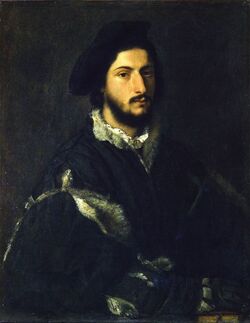Henry, Margrave of Vasiland
|
|
Henrik Vanir, known as Henry I or Henrik "the Builder" (1718-1766) was the tenth Baron of Vasiland upon his father Iver Vanir's abdication, and later became the Margrave of Vasiland.
Early Life
Henrik was typically isolated and withdrawn during his younger years. He spent most of his time within the Vanir manor in Reza, studying various histories and studies to nurture himself as he came of age, preparing to become the patriarch of his house. Despite his lonely and detached nature, many would describe the young man as ambitious. During his youth, his ambition was amplified when his family's ancient title, the March of Vasiland, was reduced to that of a baronial status. At the age of 19, Henrik received the Barony of Vasiland due to Iver Vanir's abdication, his father claiming he had been doing a poor job as Baron.
Reign
Motivated to restore the House of Vanir its lost reputation and recognition, Henrik found himself entering the world of politics. He was a leader of the Feudalist Bench in the Royal Duma with many noticing his well-versed nature in politicking. Quickly, he would rise to become the Leader of the Opposition in the Duma, the main challenger to the Palatine and centralization efforts in Haeseni government. His tenure is best known for his attempted impeachment of the Lord Palatine Markus Kortrevich after his reckless ceasing of Duma operations. Through his work, he would gain some supporters - he and his house slowly gaining relevance once again.
Henrik would not remove himself from the militant affairs of the Kingdom despite his political career, though. He was a skilled swordsman and javelineer, as well as a horseman. He was a member of the Haeseni cavalry chapter for a time, participating in many battles and skirmishes particularly in the Rubern War. He also was the second-in-command of the Barayan company for the short time of its existence, working with skilled warriors in several raids. He was adorned with medals for his prowess in the Siege of Reza and the Battle of the Hangman's Bridge.
In 1753, however, Henrik's focus would completely turn to his role as the newly-appointed Lord Speaker of the Royal Duma. He served for 12 years until stepping down due to illness. Henrik would be rewarded for his work by being granted his life's goal, the March of Vasiland title. Along with it, he was given a parcel of land in northern Arcas where the Holy Orenian Empire had taken territory from the Archduchy of Suffonia. There he would tame the lands, building his castle 'Serpentstone' (this, along with his work to restore Vanir to relevance, earned Henrik his family moniker, 'the Builder').
Lord Speaker of the Royal Duma
Henrik ascended to the position of Lord Speaker in 1753 with his predecessor Sigmar's recommendation and Andrew IV's confirmation, due to his renowned and inspired work as a politician in the Duma. His ascension was somewhat controversial because of his past as a partisan. However, despite his Feudalist background, he would remain relatively impartial. He made some controversial decisions and reforms that actually gave centralists more of a foothold within the Duma, such as removing all seats of cadet houses in the chamber.
His Feudalist background would not completely fade. He was a member of the Valwyck Pact, a political alliance against the regency of Otto Sigmar. His position as an Aulic councillor made him a notable affiliate, though raised several eyebrows. Many high ranking officials called for treason charges against members of the Pact, but Otto decided to conduct several meetings and the Valwyck Compromise was eventually established, ending the massive quarrels between the pact and the regent.
Henrik's philosophy as Lord Speaker was to have as little seats as possible however retaining a strong presence of nobility within the chamber with a few elected positions for citizens. He also rejected the idea of benches, or formalized ideologies, in Duma as he matured as a Speaker. This is ironic, considering his heated bouts with his counterparts when he was the Leader of the Opposition. In 1763, Henrik issued the Dissolution of the Benches, ending the formal recognition of ideologies in the Royal Duma.
Final Years and Death
As Henrik continued as Lord Speaker, as well as keeping up with a particularly tense family life, his well-being declined. In 1763, he contracted tuberculosis. Ignoring pleads to stop, Henrik would continue drinking and smoking himself away, and by 1765 he was gravely ill. He resigned from his position as Lord Speaker because of his sharply declining health and in 1766 he died peacefully in Vasiland by the sea. Henrik would be given a traditional Vanir funeral and was buried in the ocean. He was succeeded by his son, Brandon II.
Issue
| Name | Birth | Death | Marriage | Notes |
|---|---|---|---|---|
| Angelika Vanir | 1740 | Alive | Ser Ivan Kort | Firstborn daughter to Margrave Henry I and Karolina of Kvasz. Disowned. |
| Brandon II, Margrave of Vasiland | 1742 | 1775 | Lorena of Mondstadt | Firstborn son to Margrave Henry I and Karolina of Kvasz. The successor to Henry I. |
| Vasili Vanir | 1744 | Alive | Unwed | Cadet son to Margrave Henry I and Karolina of Kvasz. |
| Sofiya Vanir | 1745 | 1777 | Peter I, Duke of Valwyck | Second daughter to Margrave Henry I and Karolina of Kvasz. Grand Lady of Hanseti-Ruska and Duchess-consort of Valwyck.
|

